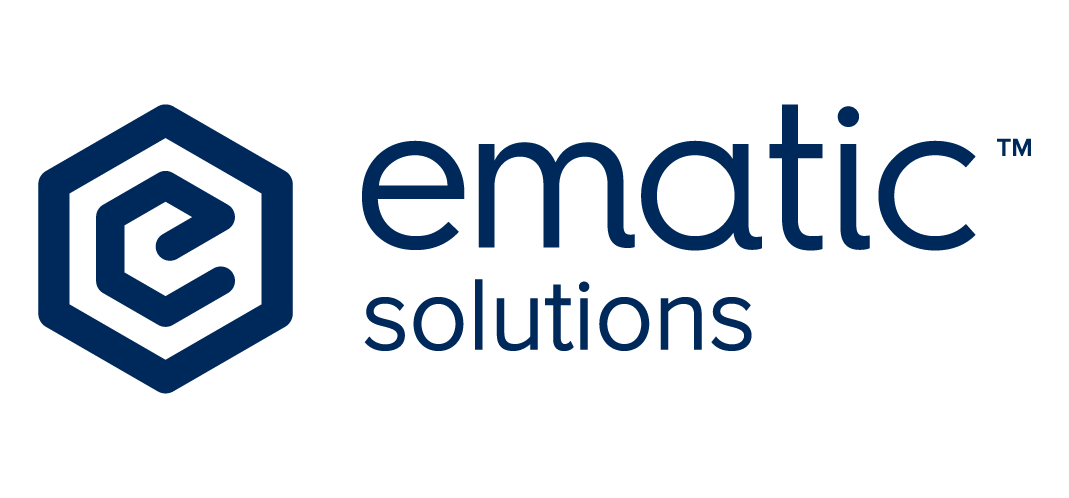How to Read Google Search Console (GSC) Data
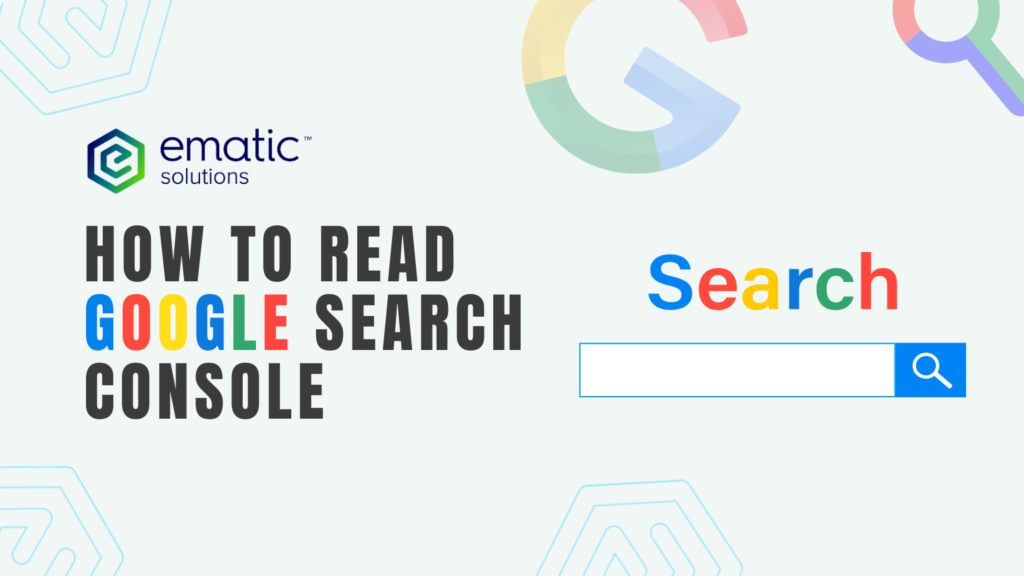
Google Search Console (GSC) is a free tool from Google that helps website owners understand how their site appears in search results. If you have an online store and haven’t set up GSC yet, you should create it now to start tracking your site’s performance. Knowing how to read GSC data can help improve your site’s visibility. This guide will break down the key reports in GSC and how to use them to optimize your website. 1. Performance Report – Measuring Website Visibility The Performance report provides insights into how users find your website and interact with it. This report is crucial for understanding your site’s visibility and identifying opportunities for optimization. The Performance report shows how your site is performing in Google Search. Here’s what to focus on: You can also view the exact queries users are searching for and their current rankings in Google SERPs. This helps you assess how to improve your website and better align it with user intent. The image below displays our organic traffic performance over time, helping us assess whether our website is improving, declining, or remaining stagnant. As shown, we can clearly see a significant improvement compared to last year’s performance. What you can do: 2. Indexing Report – Ensuring Pages Are Indexed The Indexing Report in Google Search Console helps you understand how Google crawls and indexes your website. The main categories include: Pages The Pages section under the Indexing Report helps you understand which pages on your site are indexed by Google and which ones are not. This section is crucial because if a page isn’t indexed, it won’t appear in Google’s search results. Key Metrics in the Pages Report Common Reasons Pages Are Not Indexed GSC categorizes unindexed pages into different statuses. Here’s what they mean and how to fix them: 1. Discovered – Currently Not Indexed 2. Crawled – Currently Not Indexed 3. Excluded by ‘Noindex’ Tag 4. Blocked by Robots.txt 5. Duplicate Without User-Selected Canonical 6. Alternate Page with Proper Canonical Tag 7. Soft 404 8. Page with Redirect How to Use the Pages Section Effectively 






How Backlinks Can Boost Your Organic Traffic
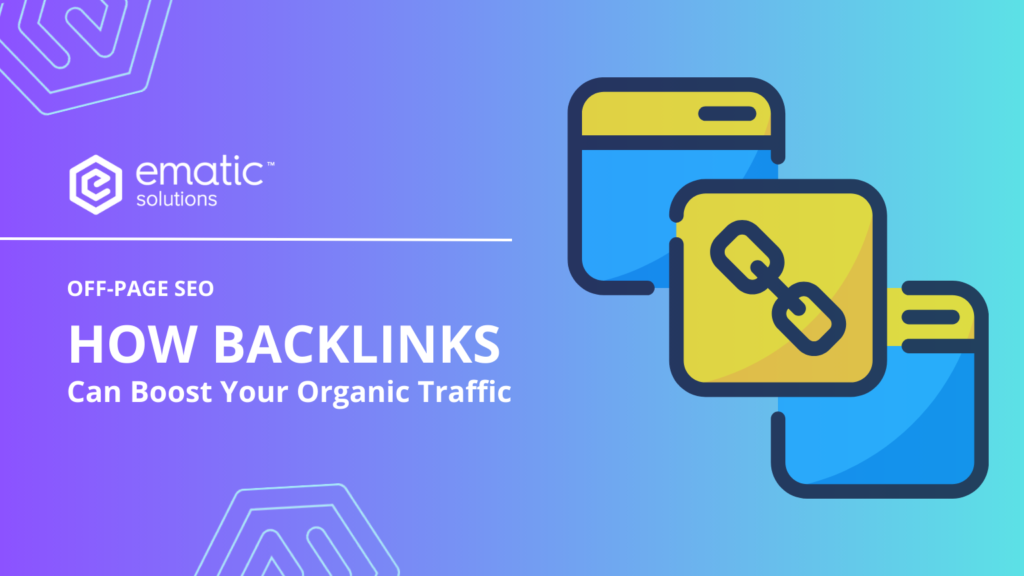
Backlinks are essential for improving your website’s visibility and driving organic traffic. Let’s dive deeper into what backlinks are, why they matter, and how you can effectively use them to boost your site’s performance. What is a Backlink? A backlink is a link from one website to another. Think of it as a recommendation or a vote of confidence. When a reputable website links to your content, it signals to search engines that your site is trustworthy and valuable. How Do Backlinks Affect Domain Authority? Domain Authority (DA) is a metric developed by Moz that predicts how well a website will rank on search engine result pages (SERPs). It ranges from 1 to 100, with higher scores indicating a greater ability to rank. Backlinks are one of the key factors influencing DA. It also helps boost your organic traffic. The higher your DA, the easier it will be to rank on Google Search. Here’s why. Credibility and Trustworthiness Backlinks from authoritative and relevant websites signal to search engines that your site is credible and trustworthy, positively impacting your DA. Increased Organic Traffic Backlinks can drive direct referral traffic to your website, which can indirectly improve your DA by showing search engines that your site is popular and engaging. Improved SERP Ranking As DA increases due to strong backlinks, your website becomes more likely to rank higher on search engine result pages (SERPs). Anchor Text Optimization When backlinks use relevant anchor text, it further helps search engines understand your content, contributing to better DA and rankings. Long-Term Benefits Backlinks provide a cost-effective strategy for sustained organic growth, as they keep benefiting your site without ongoing costs and unlike paid advertising, the benefits of backlinks are long-lasting. Once you have earned a backlink, it continues to contribute to your site’s SEO and traffic over time. How to Build High-Quality Backlinks Create Valuable Content: Produce high-quality, informative, and unique content that others want to link to. Guest Posting: Write for reputable sites in your industry and include backlinks to your site. Outreach and Networking: Contact influencers and bloggers in your niche to share your content and build relationships. Use Social Media: Share your content on social platforms to encourage others to link to it. Monitor and Adjust: Use tools like Google Search Console to track your backlinks and disavow harmful links. Tools to Help with Backlink Building Tool Features Pricing SEMRush Comprehensive suite of SEO tools, including backlink analysis, competitor research, and outreach management. Helps find backlink opportunities, track backlinks, and monitor competitors. Plans start at $139.95/month. Ahrefs Powerful backlink analysis tools with detailed insights into backlink profiles. Supports finding link-building opportunities and tracking progress. Plans start at $99/month. Moz Tools for link building, keyword research, and site audits. The Link Explorer tool analyzes backlink profiles and identifies new opportunities. Free for checking up to 3 domains per day. Plans start at $99/month. SE Ranking User-friendly SEO platform offering backlink tracking, website audit, and keyword rank tracking. Includes backlink checker and competitor backlink analysis. Plans start at $39/month. Common Mistakes in Backlink Building Backlink building is a crucial component of SEO, but many website owners make common mistakes that can harm their site’s ranking and reputation. Here are some common pitfalls to avoid: Getting low-quality backlinks from spammy or irrelevant websites can harm your ranking. Focusing on quantity over quality, leading to a poor link profile. Ignoring anchor text optimization, resulting in unnatural linking patterns. Not maintaining links, leading to broken or outdated links. Targeting the wrong audience or niche for backlinks, wasting efforts and missing potential traffic. — Do you think backlinks are important? I’d say they’re essential. Backlinks play a crucial role in your SEO strategy, helping to improve search engine rankings, drive referral traffic, build credibility, speed up indexing, and foster industry connections. By focusing on securing high-quality backlinks from reputable sources and leveraging the right tools, you can significantly increase your organic traffic and achieve sustainable success. Would you like more specific strategies on how to build backlinks for your website? Contact us for a FREE SEO audit today and get personalized insights to improve your online presence!
Must-Have SEO Tools for 2025
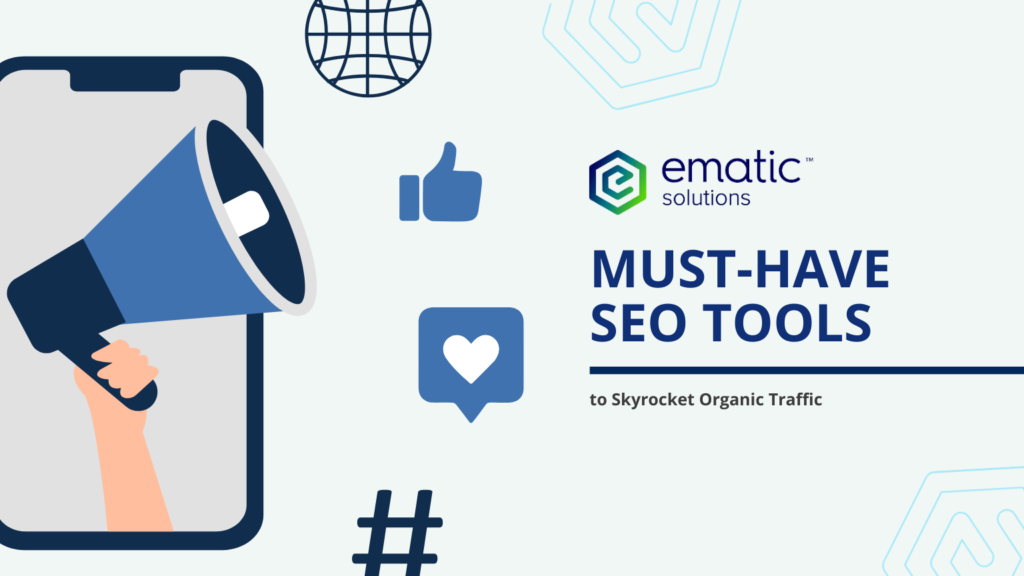
Search Engine Optimization (SEO) is essential for improving the visibility and ranking of your website on search engine results pages (SERPs). With a myriad of tools available, it’s crucial to know which ones can best meet your needs. This article explores top-ranking SEO tools to give you a comprehensive guide. What Are SEO Tools and Why Do You Need Them? Search Engine Optimization (SEO) tools are software designed to help websites rank higher on search engines like Google. Whether you want to attract more visitors, improve your website’s performance, or understand your audience better, these tools are essential. They simplify complex tasks like analyzing keywords, checking website speed, and tracking your progress. With the right SEO tools, you can: This guide will walk you through beginner-friendly SEO tools that are practical and easy to use. The Top 6 SEO Tools Function for 2025 Google’s SEO Tools The SEO sun rises and sets on the Google empire. Google’s own search optimization tools are powerful, accurate, and indispensable—they just don’t fit neatly onto this list. Even if you spend up on every product on this list, you’ll probably still use these FREE tools. Tool Purpose Features Google Search Console It provides valuable insights into how your site performs on Google Search, highlights indexing issues, and offers data on search queries that drive traffic to your website. Best of all, it’s free. – Performance reports and coverage details- URL inspection tool- Sitemap submission- Alerts for issues like crawl errors or manual actions Google Analytics 4 GA4 brings a fresh approach to web analytics, focusing on events-based tracking and providing deeper insights into user behavior across devices. – Tracks website traffic and user behavior- Conversion rates tracking- Customizable reports and dashboards- Audience segmentation tools Google Trends Explore global search trend data – Capitalize on timely queries- Analyze search interest over time- Compare different search terms- Discover related topics and queries Google Keyword Planner Discover cost-per-click keyword ideas and research search query statistics – Provides search volume data- Displays competition levels- Suggested bid estimates for Google Ads- Keyword filtering and targeting options Google PageSpeed Insights Analyze your website’s speed and offer suggestions for improvement – Measures page speed for both mobile and desktop- Provides actionable recommendations- Mobile usability insights Google Rich Results Test Check if your structured data (Schema) is properly implemented – Validates schema markup for rich results- Shows which rich results can appear based on structured data- Identifies potential errors in markup Google Lighthouse Provide a comprehensive audit of your website – Performance, accessibility, and SEO audits- Actionable recommendations for improvements- Best practices for website optimization Google’s suite of SEO tools is an essential resource for anyone looking to optimize their website and improve search performance. These free tools provide invaluable assistance for both beginners and experts alike. Leveraging them effectively can lead to better search rankings, higher visibility, and an enhanced user experience, making them indispensable for any SEO strategy. Other Essential SEO Tools While Google’s tools form the backbone of many SEO strategies, there are several other essential tools that offer unique features and insights. All-in-one SEO Tools solution Here’s a list of all-in-one SEO solutions that cover keyword research, technical SEO, competitor analysis, content optimization, and more. These tools are ideal for managing comprehensive SEO campaigns: 1. SEMrush SEMrush is a versatile platform offering features for SEO, PPC, content marketing, and social media management. Key Features: Why Use It: Perfect for agencies and businesses that need a unified dashboard for all SEO-related tasks. 2. Ahrefs Ahrefs is known for its robust backlink analysis and keyword research capabilities, but it also offers site audits and content analysis tools. Key Features: Why Use It: Ideal for SEOs who prioritize data accuracy and competitive analysis. 3. Moz Moz Pro combines an intuitive interface with reliable SEO tools for rank tracking, keyword research, and on-page optimization. Key Features: Why Use It: Great for beginners and professionals who need actionable insights with ease. 4. SE Ranking SE Ranking is an affordable solution that doesn’t compromise on functionality. It offers tools for keyword research, site audits, and competitor tracking. Key Features: Why Use It: Perfect for small to mid-sized businesses looking for a cost-effective, all-in-one SEO platform. These all-in-one SEO solutions help simplify your workflow, providing a centralized platform for all your SEO needs. Let me know if you’d like to include more tools or further refine this list! SEO Tools Plugin An SEO plugin is a tool that helps optimize a website for search engines. It provides various features and functionalities to improve on-page SEO, including keyword analysis, meta tags management, content optimization, XML sitemaps, schema markup, and more. Popular SEO plugins include: Yoast SEO Offers keyword optimization, readability analysis, and easy management of meta tags. Compatible with WordPress and it’s free! There’s also a paid version that unlocks additional features, but the free version covers most of what you need. It helps optimize content for both search engines and users, with suggestions to improve keyword density, readability, and overall SEO performance. The plugin also generates XML sitemaps and provides social media integration. All in One SEO (AIOSEO) A versatile plugin for optimizing titles, descriptions, and meta tags. It provides a comprehensive toolkit for improving on-page SEO, including features like XML sitemaps, Google Analytics integration, and the ability to set canonical URLs. It’s user-friendly and allows for advanced configuration, making it suitable for both beginners and experienced users. The plugin supports a wide range of content types, including WooCommerce and custom post types. Rank Math Provides detailed SEO analysis and suggestions, and integrates advanced SEO features like schema markup. Rank Math is known for its user-friendly interface and its ability to optimize SEO for any type of content. The plugin offers a comprehensive set of tools, including keyword tracking, automated SEO audits, and a rich snippet generator. Its free version is packed with features, but the premium version offers even more advanced functionalities such as advanced schema types and integration with Google Search Console.
Top SEO Best Practices for 2024

As a businessperson in this digital era, learning the art of search engine optimization (SEO) is critical to fostering a strong online presence. Search engines process over 3 billion searches every day, and it has been a very important thing to know how to optimize your content for a better ranking. This article is here to inform you about SEO best practices in 2024, so you can move through an ever-evolving landscape that includes search engine algorithms. 1. Understand User Intent Before getting into the more nitty-gritty details, it is important to understand the concept of user intent. The truth is that search engines like Google have become really good at understanding what a user is really looking for when they type in a query. There are four key types of user intent: Align the intent you’re targeting with your content. For instance, in the case of an informational query, your content should be educative with detailed information. Consider the keyword “what is whey protein made of.” This keyword clearly indicates an informational intent, as search results primarily display articles that educate users on advantage and disadvantages of whey protein. By understanding user intent first, you can choose the right keywords to target, ensuring your content is relevant and valuable to your audience. 2. Carry out extensive keyword research Keywords are basically the base of SEO: terms and phrases people type in to look for information on the web. Good keyword research is what allows you to find out about your audience—what they are looking for and how you can write your content to meet their requirements. Recommendation to conduct keyword research: If you utilize keyword research tools, it becomes significantly easier to analyze all relevant keywords, along with their associated metrics. These tools provide valuable insights, such as search volume, search intent, and related keywords, allowing you to make informed decisions about which keywords to target. By understanding this data, you can effectively optimize your content strategy to better meet your audience’s needs and improve your search engine rankings. 3. Optimize On-Page Elements On-page SEO is a practice in which one can optimize individual web pages to get higher and relevant traffic within SERPs. Let me take you through the most prominent on-page elements. Make sure each content piece is optimized for a primary keyword, and secondary keywords are naturally included in the text. 4. Create High-Quality, Engaging Content Content is king in the world of SEO. High-quality content brings people to your website and gets them to stick around. That’s going to lower the bounce rate and increase your ranking in searches. Advice: 5. Enhancing the Speed of Your Site and Mobile Google has clearly signaled that it considers site speed and mobile friendliness as two primary elements in rankings. High bounce rates may hurt your SEO if you have a slow and clunky website. Action Point: 6. Look into Technical SEO Technical SEO is the optimization of the infrastructure of your website to make it easy for search engines to crawl and index your content. Even though this may sound highly sophisticated, it plays an indispensable role in improving the visibility of your site. 7. Build Quality Backlinks Still one of the top-ranking factors is backlinks—these inbound links are from other websites. However, backlinks shouldn’t be done in quantity; they should have quality. Approach: 8. Use Analytics and Monitoring Tools SEO isn’t something you do just once; it’s ongoing and something you must keep doing to stay ahead of the game. SEO tools suggestion: 9. Optimize for local SEO It is a must to implement local SEO if you have brick-and-mortar stores. Guideline: Final Thoughts Search engine optimization is an ongoing and dynamic process. Practice the abovementioned best practices, and visibility on your website will increase, traffic will improve, and ultimately ranking on search engines will be better. Remember, the secret of really good SEO is not in observing the rules but in really understanding your audience and creating content that truly gets them. Keep improving your strategies, updated with the latest trends in SEO, and watch your online presence grow. Want to see how your website is performing in search results? Contact us for a free website audit!
Digital Marketing: Definition, Strategies, & Example
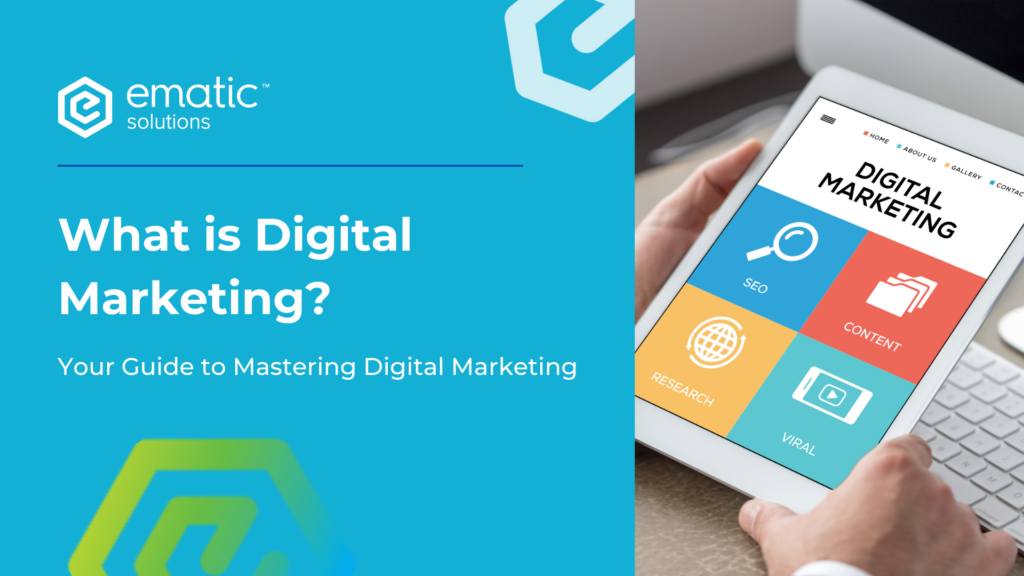
Digital marketing has become the cornerstone of modern marketing strategies, allowing companies to
Understanding Canonical Tags: Enhancing SEO with Content Consistency
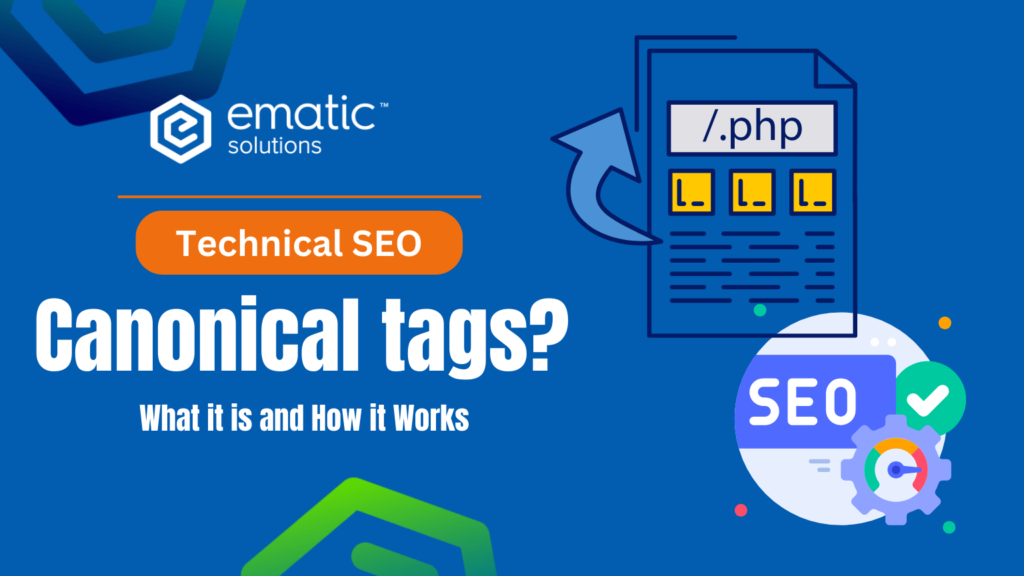
In the field of search engine optimization (SEO), maintaining content consistency across web pages is paramount. As websites grow in complexity and scale, ensuring that search engines properly index and rank content becomes increasingly challenging. This is where the canonical tag plays a crucial role – a powerful tool that helps webmasters and SEO professionals address duplicate content issues and improve site performance. What is a Canonical Tag? A canonical tag, also known as rel=”canonical”, is an HTML element that specifies the preferred version of a web page among multiple URLs with similar or identical content. It serves as a signal to search engines, indicating which URL should be treated as the authoritative source for indexing and ranking purposes. When multiple URLs contain identical or highly similar content, search engines may struggle to determine which version to prioritize in search results. This can dilute the visibility and ranking potential of individual pages, leading to suboptimal SEO outcomes. By implementing a canonical tag, website owners can consolidate duplicate content signals and consolidate ranking authority, improving the overall performance of their site in search engine results pages (SERPs). How Does a Canonical Tag Work? The canonical tag is added to the HTML <head> section of a web page and specifies the canonical URL that search engines should consider as the preferred version. For example: <link rel=“canonical” href=“https://www.example.com/page” /> In this example, the canonical tag indicates that the URL “https://www.example.com/page” should be treated as the canonical (or preferred) version of the content. When search engines encounter this tag, they attribute the content’s indexing, ranking, and link equity signals to the specified canonical URL, consolidating its authority and mitigating the impact of duplicate content issues. Using A Real-Life Case In practice, website owners often encounter challenges related to canonicalization, particularly when managing filter or parameterized URLs. One common issue arises when filter pages, such as category or product sorting pages, are not properly canonicalized to their parent pages. The filter URLs contain unnecessary or incorrectly configured parameters, such as sorting options, pagination, or session identifiers. As a result, search engines index multiple variations of the same content, leading to duplicate content concerns and dilution of ranking authority. For example, consider a website selling flowers with filter pages for different price ranges and flower types. This is an example of how the current page URL setup appears when a user clicks on their filter option: https://example.com/collections/lilies/myr300-myr399 https://example.com/collections/lilies/myr300-myr399+eustomas https://example.com/collections/lilies/myr300-myr399+eustomas+roses https://example.com/collections/lilies/eustomas+roses+myr500-myr599 As you can see from the above links, they display non-filter parameters. If these filter pages are not properly canonicalized to their parent page (e.g., https://example.com/collections/lilies), search engines may interpret them as separate, duplicate content. To address this issue, website owners should ensure that filter pages are properly canonicalized to their parent pages, indicating the preferred version of the content to search engines. Alternatively, the website owner could fix the parameter page setup to be something like (e.g., https://example.com/collections/lilies?filter.vprice.gte=200-300) and make sure to set its canonical URL to be https://example.com/collections/lilies and create a no-index for filter pages in the robots.txt file. This is how the correct parameter and canonical for filter page setup should be done as the example below. Here’s a breakdown of why this setup is correct and important: Aspect Description Canonical Tag in HTML The ‘<link rel=”canonical” href=”https://example.com/collections/flowers-bouquet-malaca”>‘ tag in the HTML of the page indicates to search engines that the preferred version of the URL is the canonical URL without any filter parameters. This helps consolidate the ranking signals and avoids duplicate content issues. URL with Parameters The URL shown in the browser (https://example.com/collections/flowers-bouquet-malaca?filter.v.price.gte=500) contains filter parameters which are typically used for sorting or filtering products. These parameters can create multiple variations of the same content, leading to potential SEO issues if not properly canonicalized. Canonicalization Process By setting the canonical URL to the main category page (without parameters), you instruct search engines to treat all parameterized versions as the same page. This ensures that the page’s ranking power is not diluted across multiple URLs and that only the preferred URL is indexed. Why Are Canonical Tags Important for SEO? Canonical tags play a crucial role in optimizing website performance and enhancing SEO outcomes in several ways: Aspect Description Duplicate Content Mitigation By specifying the canonical URL for similar or duplicate content, website owners can prevent search engines from indexing multiple versions of the same content. This helps avoid potential penalties for duplicate content and ensures that ranking signals are consolidated for optimal SEO performance. Consolidation of Ranking Authority Canonical tags consolidate the ranking authority of multiple URLs into a single canonical version, maximizing the visibility and ranking potential of the preferred content. This enhances the likelihood of appearing prominently in search results for relevant queries, driving organic traffic to the site. Improved User Experience By directing search engines to the preferred version of a page, canonical tags help streamline the user experience by reducing the likelihood of users encountering duplicate or irrelevant content in search results. This enhances user satisfaction and encourages engagement with the site. Best Practices for Implementing Canonical Tags To maximize the effectiveness of canonical tags and optimize SEO outcomes, consider the following best practices: Here are some advanced approaches for handling tricky canonicalization scenarios: In conclusion, canonical tags are a vital component of SEO strategy, enabling website owners to address duplicate content issues, consolidate ranking authority, and enhance the user experience. By implementing canonical tags effectively, webmasters can optimize their site’s performance in search engine results and drive organic traffic to valuable content. Want to Know More About SEO? Contact Ematic Now for a Free Website Audit!
SEO vs. SEM: Demystifying the Search Engine Landscape
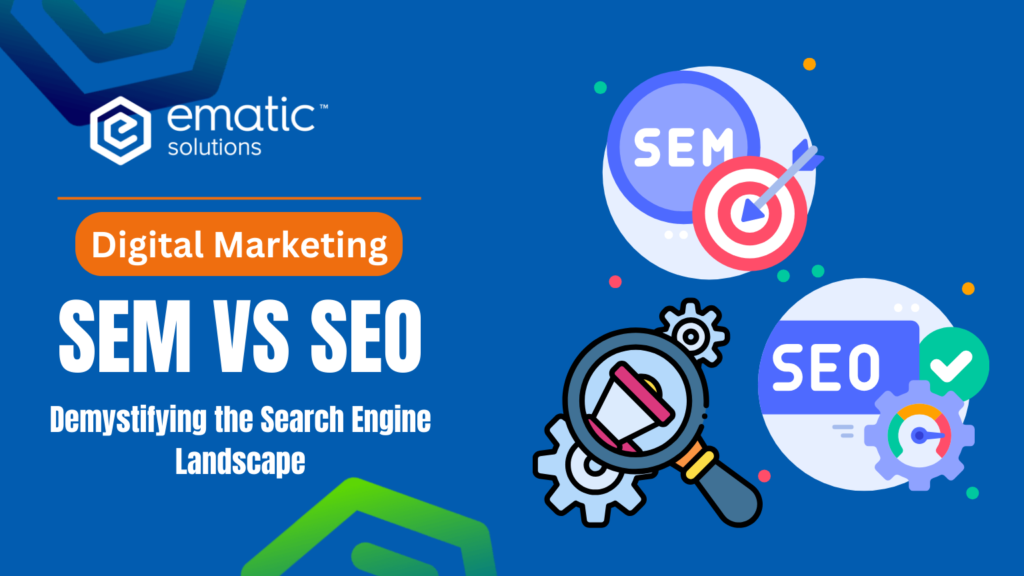
In today’s digital world, capturing online attention is crucial for businesses. Two prominent strategies for achieving this are Search Engine Optimization (SEO) and Search Engine Marketing (SEM). While both deal with search engines, they differ in their approach. Understanding these differences is essential for crafting an effective online marketing strategy. SEO: The Organic Approach SEO is the art of optimizing your website to rank higher in organic search results. When users search for relevant terms, your website aims to appear on the first page, ideally at the top. This increases the chances of users clicking on your website and engaging with your content. Here are some key aspects of SEO: SEM: The Paid Approach SEM encompasses a broader spectrum, including both organic and paid methods to increase search engine visibility. While SEO focuses on organic rankings, SEM incorporates paid advertising, primarily through Pay-Per-Click (PPC) campaigns. Here’s how PPC works: Choosing the Right Approach The ideal approach depends on your specific needs and resources. Approach Description Suitability SEO Offers long-term benefits with potentially high returns on investment (ROI) but requires sustained effort and expertise. Suitable for businesses with a long-term perspective and the ability to invest in content creation and website optimization. Businesses with long-term goals, resources for sustained effort and expertise in content creation and website optimization. PPC Provides faster results and allows for targeted advertising to reach specific audiences. However, it requires ongoing investment, as ad costs can accumulate quickly. Suitable for businesses seeking immediate results, promoting specific campaigns, or targeting a niche audience. Businesses seeking immediate results, promoting specific campaigns, or targeting a niche audience, with resources for ongoing investment in advertising. The Synergy of SEO and SEM Many businesses opt for a combined approach, leveraging both SEO and SEM for optimal results. This can involve using SEO to establish a strong organic foundation while using PPC to target specific keywords, launch time-sensitive campaigns, or reach new audiences. — Understanding the distinctions and potential of SEO and SEM empowers businesses to make informed digital marketing decisions. Whether you choose an organic, paid, or combined approach, remember that a well-defined strategy tailored to your specific goals is key to achieving success in the ever-evolving search engine landscape. Ematic Solutions SEO and SEM Service Overview: Our approach is characterized by: Contact us now for a free consultation.
CRO: What it is and how to get started
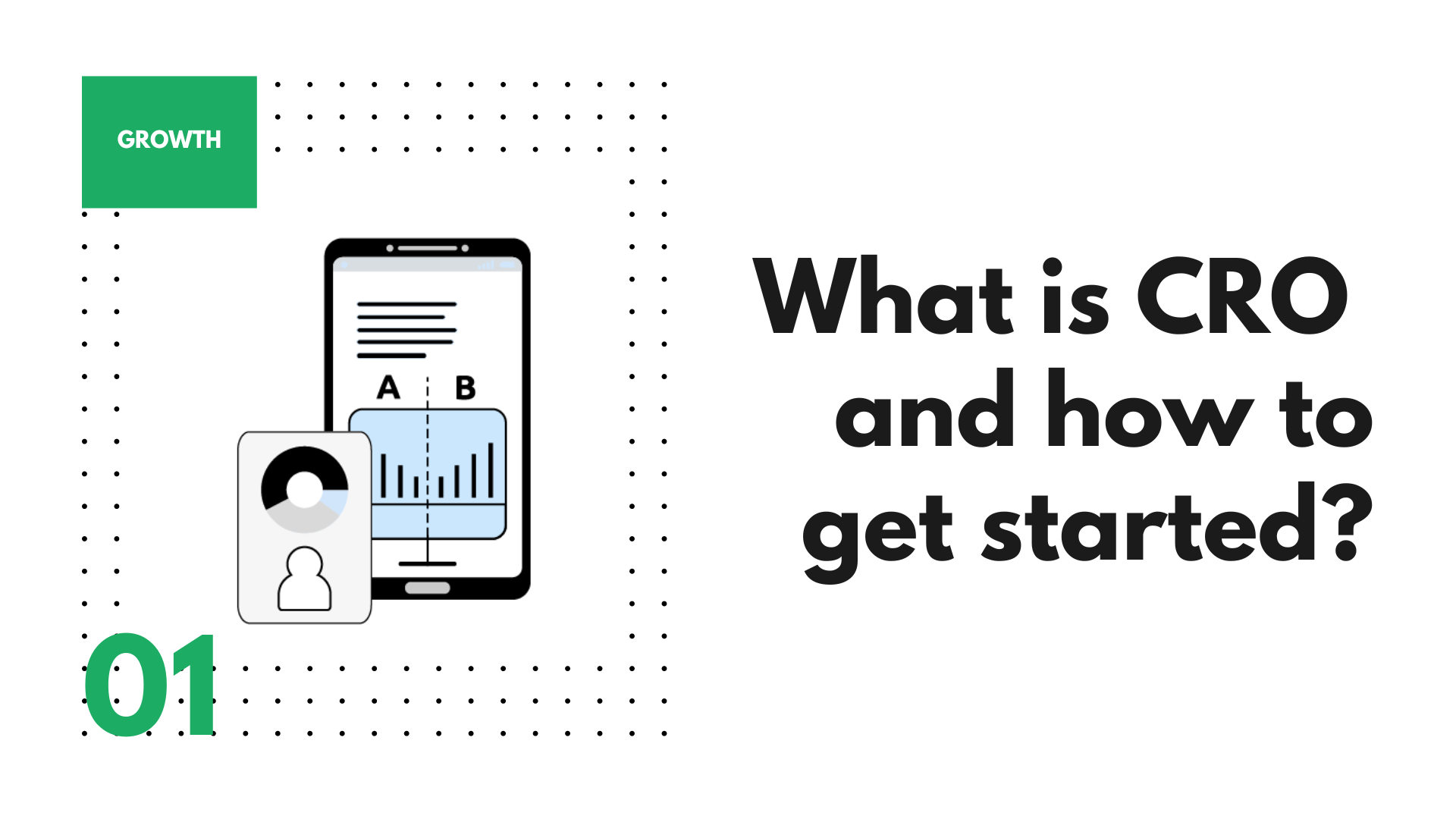
Conversion rate optimization (CRO) is the process of improving the percentage of visitors to your website who take a desired action, typically leading to a purchase. In the context of e-commerce, CRO specifically aims to optimize your online store to boost sales. As an E-commerce business, your goal is simple – to grow your online revenue. CRO is a data-driven process that involves testing and experimentation. It is also important to have a clear understanding of your customers and their needs to be successful with CRO. If you want to improve your website’s CRO, there are various actions you can take on different parts of your site. For example, you can enhance your product pages to boost sales, streamline the checkout process, improve your blog, add personal touches, use pop-up messages, apply psychological principles, and explore various other strategies. Why is CRO important? CRO is important because it can help you increase your website’s revenue and profitability. By improving your conversion rate, you can get more value from your existing traffic. CRO can also help you improve your website’s user experience and make it more likely that visitors will return to your site in the future. With a good CRO strategy, you can harvest multiple benefits: CRO will save you money Gain insights about your customer’s behavior Improve ROI and marketing efficiency Enhance your site’s usability, navigation, and user experience Make decisions based on data and insights, not instinct How to start optimizing your conversion Now you’ve learned the benefits of CRO, but where to start? We’ve broken down key steps into the following sections: process, tools and testing targets to give you an overview. Process CRO places a huge emphasis on testing and experimentation which should be conducted using the scientific method. Let’s look at the steps involved: 1) Gather data & insights Data and insights are always your starting point. At this stage, you’d want to gather both qualitative & quantitative data as much as possible, to help you get an overview of your conversion problem. Funnel & web analytics: From when the customer comes to your website to perform the action (e.g complete a checkout), the journey often involves several, interconnected steps. Like fixing a leaking pipe, you’ll want to break down the funnel and learn where your customers drop off the most. UX heuristic evaluation: Sometimes your conversion problem is as simple as it’s not user friendly enough. Is the navigation clear for customers? Is the message consistent? A UX heuristic audit gives you clues of conversion problems resulting from usability issues. Market research: Each industry has its unique landscape and consumer behavior. Doing competitive research to understand your general positioning, offering and pricing and consumer preference helps you assess conversion from a high business level. 2) Formulate hypotheses Once you consolidate all the findings, the next step is to formulate a hypothesis. We are not jumping into complicated statistical hypotheses yet, but at bare minimum, your hypothesis should consist of three important elements – reasoning, testing variable/action and the desired result. The sentence structure might look like this: “Based on (your finding), we believe we can achieve (desired result) by (testing variable/action).” Let’s try with an example: “Based on the fact that social proof gives consumers confidence in product quality, we believe we can increase more purchases by adding customer feedback on product pages.” 3) Run a test After narrowing down the hypotheses and areas you’d like to test, you’ll then move to designing and performing the tests. AB testing (single variate testing) or multivariate testing are the most common methods used. You’ll want to make sure you have proper tools to split the controlled/testing environment and accurate data tracking to help you monitor the results. 4) Analyze Now it’s time to validate your ideas with data evidence. Judging by the result, is your hypothesis correct? If not, how can you potentially explain the reason? Is there a new hypothesis? Was the experiment flawed? This is the most crucial (yet sometimes neglected) step to learn from the experiments and adjust your testing plan. 5) Reiterate and repeat Although we call it step 5 here, CRO is indeed not a linear process. Once you gain some thoughts from the previous step, it’s time to decide how to carry the next step. Was the experiment successful? Great! Can you take it to the next level? Should you move on to test other new ideas? If not, should you form a new test based on the corrected hypothesis? CRO is a cycle of continuous hypothesis, testing and learning. CRO analytic tools There are many tools to help you conduct CRO smoothly. Below we will provide a few examples: 1. Quantitative user analytic tools A quantitative analytic tool helps you understand through numerical data, what happened on your website and/or app. You can use such tools to answer: How engaged are your customers? Which User groups are engaging less? How long did your customers visit? How many pages have they viewed? How many customers go through a specific funnel? Where do they drop off? What are the most popular paths of your customers? What products or pages receive the most attention? Some of our best picks for quantitative user analytic tools include: Google Analytics 4 Google Analytics is the most commonly used analytics platform in the world. Recently, Google introduced the new Google Analytics 4 (the Universal Analytics , i.e. old GA, will be sunsetted by Jul 1, 2023. If you haven’t migrated to GA4 yet, let us give you a hand). Not only can you analyze traffic, but the new GA4 also offers enhanced insights on customer journeys and makes it easier to do funnel analysis, path exploration etc. Best of all, it’s free! Mixpanel Mixpanel is a powerful self-service, event-based analytics tool that provides valuable customer insights with the ease of data visualization. It is one of the popular analytic tools. They currently help the world answer 81 million product
Understanding Search Intent: Top vs. Bottom of Funnel Keywords in SEO

In the vast digital landscape of the internet, where information is abundant and competition is fierce, understanding the nuances of search intent is crucial for the success of any online business.
